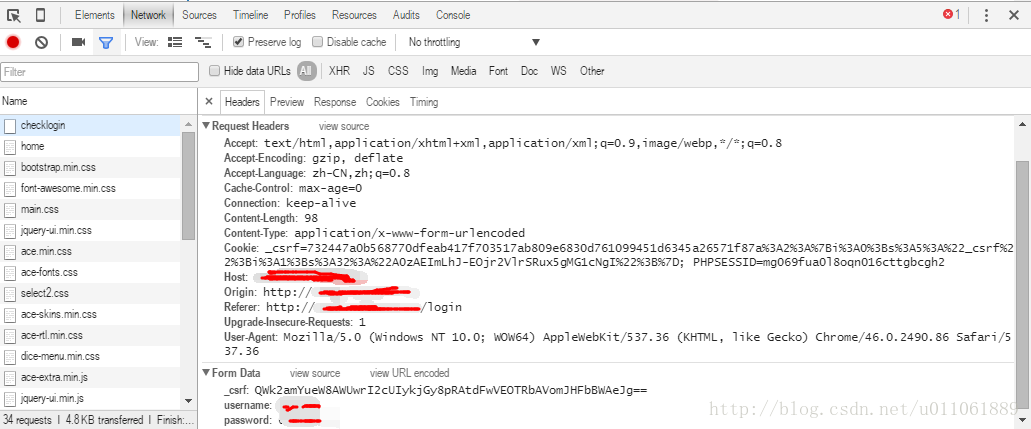Python Requests包模拟登陆 怎样使用Python的Requests包实现模拟登陆
春风不及你的笑 人气:0前段时间喜欢用python去抓一些页面玩,但都基本上都是用get请求一些页面,再通过正则去过滤。
今天试了一下,模拟登陆个人网站。发现也比较简单。读懂本文需要对http协议和http会话有一定的理解。
注明:因为模拟登陆的是我的个人网站,所以以下代码对个人网站和账号密码做了处理。
网站分析
爬虫的必备第一步,分析目标网站。这里使用谷歌浏览器的开发者者工具分析。
通过登陆抓取,看到这样一个请求。
上方部分为请求头,下面部分为请求是传的参数。由图片可以看出,页面通过表单提交了三个参数。分别为_csrf,usermane,password。
其中csrf是为了预防跨域脚本伪造。原理很简单,就是每一次请求,服务器生成一串加密字符串。放在隐藏的input表单中。再一次请求的时候,把这个字符串一起传过去,为了验证是否为同一个用户的请求。

因此,我们的代码逻辑就有了。首先请求一次登录页面。然后分析页面,拿到csrf字符串。最后把这个字符串和账号密码一起传给服务器用来登录。
第一份代码
#!/usr/bin/env python2.7
# -*- coding: utf-8 -*-
import requests
import re
# 头部信息
headers = {
'Host':"localhost",
'Accept-Language':"zh-CN,zh;q=0.8",
'Accept-Encoding':"gzip, deflate",
'Content-Type':"application/x-www-form-urlencoded",
'Connection':"keep-alive",
'Referer':"http://localhost/login",
'User-Agent':"Mozilla/5.0 (Windows NT 10.0; WOW64) AppleWebKit/537.36 (KHTML, like Gecko) Chrome/46.0.2490.86 Safari/537.36"
}
# 登陆方法
def login(url,csrf):
data = {
"_csrf" : csrf,
"username": "xiedj",
"password": "***"
}
response = requests.post(url, data=data, headers=headers)
return response.content
# 第一次访问获取csrf值
def get_login_web(url):
page = requests.get('http://localhost/login')
reg = r'<meta name="csrf-token" content="(.+)">'
csrf = re.findall(reg,page.content)[0]
login_page = login(url,csrf)
print login_page
if __name__ == "__main__":
url = "http://localhost/login/checklogin"
get_login_web(url)
代码看起来好像没有什么问题。然而执行的时候出错了。核查了一下,错误的原因是,csrf验证失败!
再多次确认获取的csrf和请求登录的csrf字符串没问题了之后,我想到了一个问题。
如果,大家还不知道错误原因的话,这里可以暂停思考一个问题。“服务器如何知道,第一次请求获取csrf和第二次post登录请求是同一个用户?”
到这,应该都清楚了,如果要登录成功,需要解决如何让服务相信两次请求是同一个用户。这里需要用到http会话(不清楚的可以自行百度,这里简单介绍)。
http协议是一个种无状态的协议。为了使这种无状态变得有状态,因此引进了会话。简单的讲,通过session去记录这个状态。当一个用户第一次请求web服务的时候,服务器会生成一个session,用于保存这个用户的信息。同时,在返回给用户端时,把这个sessionID保存在cookies里。当用户再一次请求的时候,浏览器会把这个cookies带上。因此在服务器端就能知道多次请求是否为同一个用户。
因此我们的代码,需要在第一次请求的时候拿到这个sessionID。第二次请求的时候把这个sessionID一起传过去。而requests厉害的地方就是,一句简单requests.Session(),就能使用这个会话对象。
第二份代码
#!/usr/bin/env python2.7
# -*- coding: utf-8 -*-
import requests
import re
# 头部信息
headers = {
'Host':"localhost",
'Accept-Language':"zh-CN,zh;q=0.8",
'Accept-Encoding':"gzip, deflate",
'Content-Type':"application/x-www-form-urlencoded",
'Connection':"keep-alive",
'Referer':"http://localhost/login",
'User-Agent':"Mozilla/5.0 (Windows NT 10.0; WOW64) AppleWebKit/537.36 (KHTML, like Gecko) Chrome/46.0.2490.86 Safari/537.36"
}
# 登陆方法
def login(url,csrf,r_session):
data = {
"_csrf" : csrf,
"username": "xiedj",
"password": "***"
}
response = r_session.post(url, data=data, headers=headers)
return response.content
# 第一次访问获取csrf值
def get_login_web(url):
r_session = requests.Session()
page = r_session.get('http://localhost/login')
reg = r'<meta name="csrf-token" content="(.+)">'
csrf = re.findall(reg,page.content)[0]
login_page = login(url,csrf,r_session)
print login_page
if __name__ == "__main__":
url = "http://localhost/login/checklogin"
get_login_web(url)
成功获取登陆后的页面

由代码可以知道,requests.Session()启动会话对象后,第二次请求会自动把上一次的sessionID一起传过去。
加载全部内容